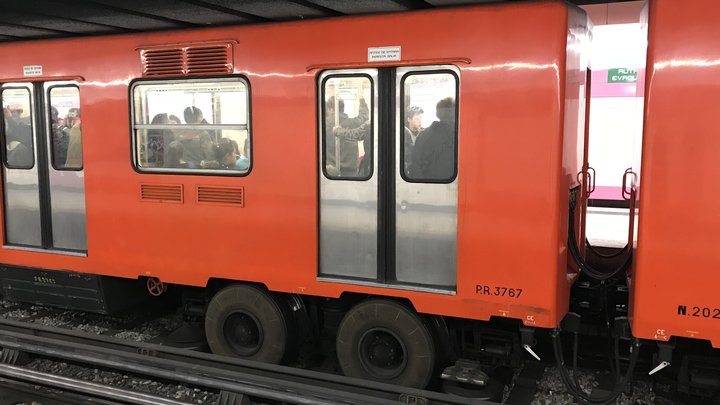“Long
before it became an archaic, filthy, profligate symbol of everything
wrong with our broken cities, New York’s subway was a marvel…”
— Jonathan Mahler

Line 1 train coming into Observatorio subway station, Mexico City. Note cleanliness, absence of graffiti. (Barry Evans)
It’s
ironic that in a week when I used — and appreciated — Mexico City’s
super-efficient subway four or five times every day, the New York
Times Magazine published a long article and alarming essay about
NYC’s failing subway system LINK. As the subway goes, so goes the
city, according to the magazine’s staff writer Jonathan Mahler in
his well-reasoned, in-depth piece. New York’s prosperity was
originally built on its subway system “tying together the modern
city and enabling it to become a place where anything was possible.”

The New York City Subway includes 424 stations on its 236 miles of routes.
Today, New York’s subway carries nearly six million people daily — but it’s falling apart. It’s not just the headlined incidents — derailment in Brooklyn, F train trapped between stations for an hour without power or A/C, track fire in Harlem — but the daily woes experienced by subway commuters. According to Mahler, 75 percent of the lines were “chronically behind schedule” during January to March of last year. Water is corroding the system, the signal system is nearly 100 years old (still not computerized!), less than 20 percent of stations are wheelchair accessible, half the railcars are over 30 years old, overcrowding is the norm … you get the picture. Over $100 billion is desperately needed to fix the system, but political wrangling is holding up repairs and modernization. As Mahler says, it’s falling apart — his feature has photos to prove it.
Meanwhile, in Mexico City, during my various visits here the subway seems to function like a charm. With an annual ridership roughly the same as New York’s (1.6 billion versus NYC’s 1.7 billion) and the second largest system in North America (second only to New York), 195 stations (compared to NYC’s 472), it just works. The longest I’ve ever had to wait for a train is ten minutes (usually much less), and during rush hour, trains come and go with awesome frequency — one leaves the station and the next one arrives 20-30 seconds later. The trains are quiet, running on pneumatic tires (most lines) — a major factor in preventing major damage during the calamitous 1985 earthquake here. They’re clean — no graffiti, can you believe? And talk about courtesy — I’ve yet to see an old, obviously pregnant or mother with young child standing.

The Mexico City Metro system has 195 stations on its 141 miles of route.

Although they’re now illegal, vendors still cruise the subway cars selling everything from videos to (here) bars of soap. (Barry Evans)
Of course, there are huge differences. The Mexico City Metro began service in 1969, while most of New York’s is over 100 years old. Mexico City’s is shorter — 140 miles, compared to nearly twice that in NYC. New York’s runs 24 hours a day, Mexico City’s 5 am to midnight. So comparisons between the two systems may be sketchy, but riding the rails here while reading about New York’s woes is a disconcerting experience. And Mexico City is far from the only place where the subway just works. Hong Kong’s subway runs 99.9% on time. London’s “tube” (1.4 billion annual ridership, began operation in 1863) is well-maintained with mostly new rolling stock, and etc. We’ve ridden metro rail systems all over, from Moscow to Madrid, Prague to Paris, Tblisi to Toronto, and agree that our experience of the NYC subway is easily the worst of these, with Mexico City the best.

Ten of Mexico City’s 12 subway lines use pneumatic tires instead of traditional steel wheels. (Barry Evans)
By way of explanation, here’s Mahler’s: “Most countries treat subway systems as national assets. They understand that their cities are their great wealth creators and equality enablers and that cities don’t work without subways.” Is that so hard to understand?
Meanwhile, we’re heading out to catch the metro, which will take us all the way across town for — are you ready for this? — 25 cents.
CLICK TO MANAGE